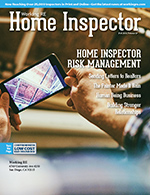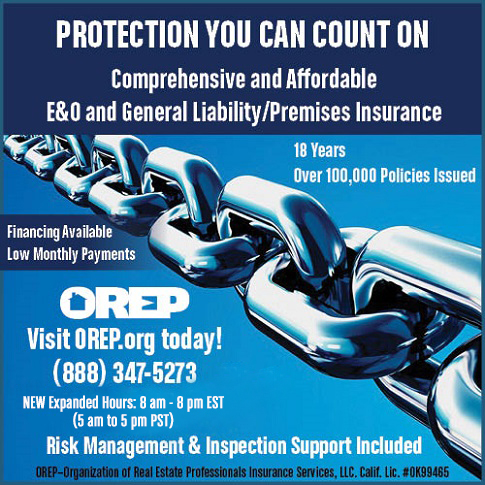 |
> E&O/GL Insurance for Home Inspectors Competitive Rates, Broad Coverage, Free Risk Management, online inspection support for tough questions, discounts on education and more... Professional Coverage, Competitive Pricing Shop OREP today! |
>> Editor’s Note: To help you stay up-to-date and connected, OREP/Working RE has established a Coronavirus (COVID-19) Discussion and Resource Page where you can share your thoughts, experiences, advice and challenges with fellow inspectors. See what Inspectors are saying here!
>> Take the Coronavirus: National Home Inspector’s Survey. Provide your industry feedback.
Home Inspector Risk Management – Part 1
by David Brauner, Senior Broker at OREP
Most of us don’t think about “risk” too often in our day-to-day lives (thank goodness!). But as professionals, part of our focus must be on risk and our potential liability, if we want to insulate ourselves and our families from catastrophic loss. No one wants to lose gains earned from many years of hard work.
As an insurance professional, I think about risk all the time—my own and my client’s. We call the insurance protection specifically designed for the work we do as professionals errors and omissions or professional liability insurance. Doing our professional work, or driving our cars for that matter, presents a risk—we pay insurance to help us manage it. And as I’m fond of saying, no one likes insurance until they need it.
At OREP we sell a program of E&O insurance specifically tailored for home inspectors, shaped over my 25 years of experience in this profession. We also publish a national magazine, that you are likely reading right now, to help all inspectors flourish—Working RE. We help OREP insureds further when a complaint happens by working with the claims professionals to review its merit and respond accordingly. And we provide risk management services to help our insureds avoid trouble in the first place—that’s what this story is about.
Your job is not easy: it takes thorough inspecting, careful report writing and prudent verbal communication to avoid complaints and claims. Some version of this is true for most professionals but particularly challenging for inspectors, in my opinion, because homeowners confuse your services with a home warranty or guarantee—which of course it is not. That’s why just a few insurance carriers choose to write coverage for inspectors. And if you’re an old–timer like me, you know there are many more choices today than there were 25 years ago. OREP has just completed a semi–annual review of our book of business. Here are some significant and preventable claims we’ve seen against inspectors over the last 12 months with some insight on how you might avoid trouble.
Be Careful Estimating Remaining “Life”
We recently defended a claim where a home inspector indicated that the roof appeared to be “new and professionally installed within the last five to seven years,” adding that the roof should “last another 20 plus years” if properly maintained. This statement, and any other statement that attempts to estimate the current age and/or remaining life of a roof or any other property component, is risky and ill-advised.
In this case, the roof was actually over 20 years old and needed to be replaced within months of the buyers moving in! In less than a year after moving in, the buyers of the home had filed a lawsuit alleging violations of the state’s consumer protection act, negligence, and breach of contract.
Ian Robertson, a veteran home inspector and contractor who also teaches home inspection courses in New York, says that this is a mistake that home inspectors make often. “I teach a liability course for home inspectors alongside an attorney here in New York,” Robertson said, “Invariably, we find glaring issues like this where the home inspector will state how new they think the roof is and estimate that it should last five to 10 years with proper maintenance. This is dangerous and is like adding flowers and bouquets to your report, when what you really should do is write down what you can see with your visual observation and move on.”
Some courts in New York have even taken issue with present tense verbs, such as “appears,” Robertson reports. “Some of the courts here have found that the present tense can be perceived as a guarantee, so we always write in past tense: ‘The roof appeared to be functional.’ Don’t make things up. We are not engineers and we are not specialists. We perform a visual inspection, we recognize defects, we report what we see, and we refer a specialist if necessary. Once you go outside of that, you’re asking for trouble,” warns Robertson.
This extends to property components that have a manufacturer’s sticker on them. “If the AC unit or water heater has a sticker showing the manufactured date, I’ll write: ‘According to sticker on side of equipment, the MFG date was 2019.’ This is because I’ve seen where the seller switched out the stickers for entire HVAC system and it brought a world of trouble for the home inspector and everyone involved in the transaction. You don’t know how old components are. Your job is to report what you see,” Robertson says.
As a professional home inspector, it’s not your job to report the precise age of a property component, much less predict how long a particular item will last. As a professional home inspector, you are not a fortune teller and you should avoid making future-predicting statements about how long a particular component will last. It is ok to say that a property component appears to be in good or even excellent condition, or that it is nearing the end of its life, but if you don’t know for certain how old it is, don’t guess. And don’t try to predict its remaining life—you don’t want to take on that liability.
(story continues below)
(story continues)
Take Pictures
Taking abundant digital pictures during a home inspection is now the norm in the profession—and for good reason. Many times it’s a home inspector’s best (and only) defense. Many insurance carriers require that you include digital photos in your reports—that’s how important a tool it is for risk management. The old adage that “a picture is worth a thousand words” is definitely true for the home inspector.
Why are pictures so important? Because pictures establish both the condition of a particular property component as well as what was visually observable on the day of the inspection. We have seen claims where new homeowners begin tearing out walls or pulling up flooring after moving in, only to find water damage or an active termite infestation. But does the inspector have pictures of the floor or of the walls to demonstrate there were no visual cues at the time of the inspection? Remember that a home inspection is a non–invasive visual inspection. You are there to report on what is visually observable at the time of the inspection. If you have photographic evidence that no defects were visible when you did the inspection, it is much harder to prove that you are negligent, in many instances.
Another reason pictures are so valuable is that they can establish what you did or did not do. Take for example a home inspector who fills up a bathtub and then drains it. The inspector may later face a claim that they failed to turn off the water before leaving the property. But if the inspector has pictures (or video) of the bathtub being filled and draining/drained, this provides strong evidence that the inspector did not leave the bathtub running. This type of scenario also highlights the importance of having date/timestamps on the photos you take. The date/ timestamp feature can be enabled in most smart phones and cameras with minimal effort and it is highly recommended as a risk management tool.
Notes on COVID-19
It’s the elephant in the room these days. I’d be remiss not to mention some of the risks involved when inspecting during the COVID-19 pandemic. For starters, home inspectors should follow the health protocols in their state/locality to ensure the safety of themselves and those they interact with. This not only protects the inspector’s own health, but should limit their liability as they are following proper safety protocols in line with industry standards. I say “should” because we really don’t know anything for sure. But we have some educated guesses.
In California, for example, the California Department of Public Health (CDPH) and Cal/OSHA issued guidelines for real estate transactions that stipulate how real estate agents should operate, including the establishment of a COVID-19 Prevention Plan on all listed properties. Because the Cal/ OSHA guidelines require that all visitors to a property, including inspectors, must confirm their understanding of the rules, the California Association of Realtors (CAR) has developed a Coronavirus Property Entry Advisory and Declaration (PEAD) form that many home inspectors are being asked to sign before being allowed access to property. The PEAD form advises that visiting properties may be unsafe and it requires the signer to attest that they will maintain social distancing, wear gloves, a face mask and shoe coverings, and that they do not currently have any symptoms or have been in contact with someone who has symptoms of COVID-19.
Some inspectors have been worrying about facing lawsuits alleging that they spread COVID-19 to the properties’ inhabitants or to others visiting the property. We spoke to an inspector recently who let his mask slip off his face and was repeatedly yelled at by the property seller who demanded that he immediately get tested for COVID-19.
While positions on this point vary, the North Carolina Association of Realtors posted this to its website: “A hold harmless agreement protects a party from liability if another party is injured on their property or is injured during an inherently dangerous activity. In the case of a pandemic, where the risks associated are not only widely known but are widespread, easily transmittable and may not show symptoms for days after exposure, proving causation would be nearly impossible from a legal standpoint.”
Insurance company guidance that I’ve seen reflects this. It would be difficult to prove the facts needed to demonstrate direct causation.
Given the concerns about virus-spread, many OREP insureds have asked whether they should sign the PEAD form mentioned above or others like it. We tell our insureds that we don’t see much risk as long as it can be signed in good faith, i.e. that you are indeed following the safety standards in your locality and don’t have any symptoms. But this doesn’t mean you should indemnify anyone or agree to pay their legal claims just to visit a property. Make sure that you read any agreement you’re asked to sign carefully and be on the lookout for hold-harmless and indemnification language. We hope this helps. Please give us a look at OREP.org if you ever need help with home inspector risk management or insurance coverage.
Don’t miss Part 2 of this Risk Management article next week!
About the Author
David Brauner is Publisher of Working RE magazine and Senior Broker at OREP, a leading provider of E&O Insurance for appraisers, inspectors and other real estate professionals in 50 states (OREP.org). He has provided E&O insurance to appraisers for over 25 years. He can be contacted at dbrauner@orep.org or (888) 347-5273. California Insurance License #0C89873. Visit OREP.org today for comprehensive coverage at competitive rates.
OREP/WRE Coronavirus Discussion and Resource Page
Coronavirus: National Home Inspector Survey
Free Risk Management Online Course Claims and Complaints: How to Stay Out of Trouble
Available Now
Presenter: David Brauner, Senior Insurance Broker OREP
David Brauner, Senior Broker at OREP, shares insights and advice gained over 25+ years of providing E&O insurance for inspectors, showing you how to protect yourself and your business. Watch Now!
Note: The Fall 2020 issue of Working RE Home Inspector mailed in October to over 25,000 home inspectors nationwide. OREP Insureds enjoy guaranteed delivery of each print magazine and many more benefits.


